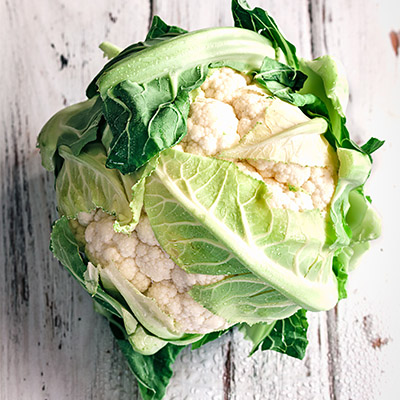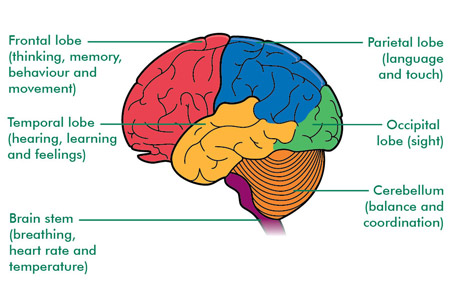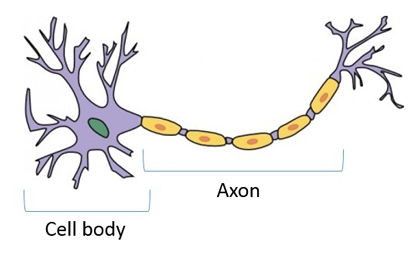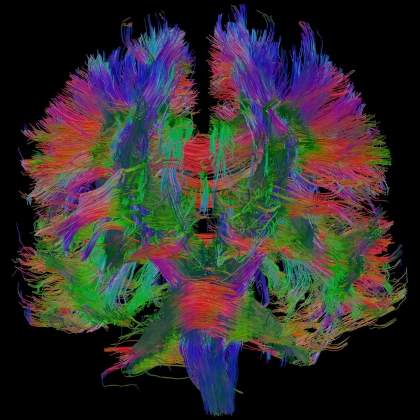Your brain – what it is and what it does

The human brain has been described as the most complex object in the universe. It’s responsible for everything you do, think, feel and say – the things that make you who you are and enable you to go about your daily activities.
Did you know...?
 The average adult brain is about the size of a medium cauliflower.
The average adult brain is about the size of a medium cauliflower.
The average adult brain contains around 100 billion brain cells. Each is connected to around 1,000 others. That’s 100 trillion connections.
The brain accounts for about 2% of total body weight, yet receives 20% of our blood supply and uses 20% of our total calorie intake.
If you took one second to count each brain cell in a single brain, it would take over 3,000 years to count them all*.
[*source: National Geographic]
My brain is the most important thing I own and I intend to take care of it.
What does your brain actually do?
Your brain has three main jobs.
-
Managing your unconscious or 'automatic' functions, such as heartbeat, breathing, digestion and control of body temperature.
- Managing your conscious or 'motor' functions, such as movement, gesturing, balance, posture and speech.
- Thinking, emotions, behaviour and senses (eg sight, sound and touch).
It's this third job that we're particularly interested in as this is where your thinking skills come in.
Thinking skills make us who we are.
They let us engage with the world around us. They include:
- memory
- paying attention to tasks at hand
- reasoning
- decision making
- problem solving
- planning and organising
- recognition, e.g. faces, sounds and smells
- understanding speech
- vocabulary and language skills
- learning.
Find out how we can we protect our thinking skills
How your brain works
Different parts of your brain have different functions.
The cerebrum
The cerebrum is the largest part of the brain and comprises two halves. The right half controls the left side of the body and the left half controls the right. The outer surface of the cerebrum is known as the ‘cerebral cortex’. It’s highly folded to increase its surface area and is organised on each side into four areas – the frontal, parietal, temporal and occipital lobes. Together, they are responsible for thinking, behaviour, movement, feelings, personality and senses like sight and hearing.
The cerebellum
The cerebellum, located above the back of the neck, is responsible for co-ordination and balance.
The brain stem
The brain stem is the lower part of the brain that connects to the spinal cord and controls unconscious functions including breathing, heartbeat, digestion and temperature control.

Image provided by Macmillan Cancer Support
Grey and white matter - why it matters
Your brain contains billions of brain cells, called 'neurons.' Each brain cell has a cell body and axons. The cell bodies appear grey-ish in colour, so they’re known as ‘grey matter’. They control all of the brain’s functions.

Image provided by the Centre for Cognitive Ageing and Cognitive Epidemiology (CCACE), University of Edinburgh
Axons radiate out from the cell bodies, forming connections – like wiring – between brain cells. Axons are protected by a fatty sheath called myelin, acting like insulation around an electrical wire. Myelin is white-ish in appearance, so these connections are known as 'white matter'.
Individual axons come together in bundles to form communication pathways in the brain. These are known as ‘white matter tracts’, illustrated by this image.

Image provided by the Centre for Cognitive Ageing and Cognitive Epidemiology (CCACE), University of Edinburgh
In the grey matter, the brain cell bodies generate information in the form of electrical signals and the axons carry the signals to other cells. White matter tracts connect different parts of the cerebral cortex and other structures, allowing communication across the brain network.
In this way, information is carried around the brain itself and, via the spinal cord and nervous system, to and from every other part of the body, e.g. muscles, glands and sensory organs (eyes, ears, skin, nose and tongue).
How your thinking skills change with age
With thanks for this page to scientists in the University of Edinburgh’s Centre for Cognitive Ageing and Cognitive Epidemiology.
